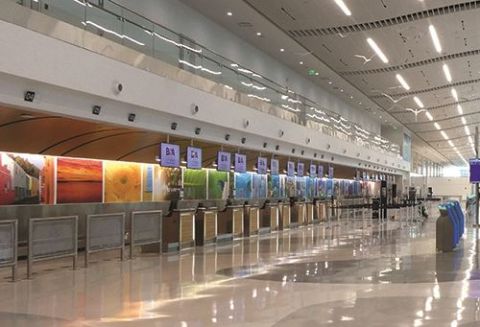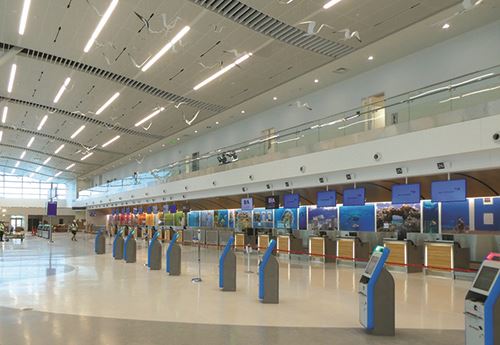Public-Private Partnership Delivers New Terminal in Bermuda

L.F. Wade International Airport (BDA) is passengers’ gateway to the iconic pink sand beaches of Bermuda. With an economy heavily rooted in tourism, this overseas territory of the United Kingdom and its airport have struggled since early 2020 because of COVID-19. However, in December 2020, a new $400 million terminal opened to welcome travelers to the Atlantic island. This major capital investment, built through a public-private partnership, positions the airport and the island for better years ahead.
 Lester Nelson, chief executive officer of the Bermuda Airport Authority, explains that BDA’s old terminal building dated back to the 1940s. It was augmented in a piecemeal fashion, with expansions and renovations completed over the years, but not in a well-planned, purposeful manner. In 2008, the government’s Airport Master Plan process determined that the existing terminal required significant investment to improve or replace it.
Lester Nelson, chief executive officer of the Bermuda Airport Authority, explains that BDA’s old terminal building dated back to the 1940s. It was augmented in a piecemeal fashion, with expansions and renovations completed over the years, but not in a well-planned, purposeful manner. In 2008, the government’s Airport Master Plan process determined that the existing terminal required significant investment to improve or replace it.
Pre-pandemic, BDA served just less than 1 million passengers each year, with peak travel between April and November. In addition to being outdated and undersized, BDA’s former terminal was dark, with low ceilings and no passenger boarding bridges. “It was just a very dated design and past its useful life,” Nelson relates.
|
Project: New Terminal Location: L.F. Wade Int’l Airport Size: 288,000 sq. ft. Cost: $400 million Airport Owner: Bermuda Government Airport Operator: Bermuda Skyport Corp. Ltd. Architect: Scott Associates Architects Inc. Construction: Aecon Concessions
Mechanical: Update Contracting, Fuel Hydrant System: Phoenix Petroleum; Raposo Welding Services Ltd. Fire Alarm & Sprinkler Systems: Air Care Bermuda; Troy Life Safety Ltd. Chilled Water, Plumbing & Refrigeration Systems: BAC Group of Companies Ventilation Systems: Keen Ltd. Electrical Systems: Update Contracting, Bermuda Airport Ltd. Electrical Distribution: Noesis Energy Solutions/Options Electrical Information Technology: SITA; Switchworx Baggage Handling Systems: Glidepath Systems Ltd.; Koba Industries Ltd. |
Following the Great Recession, the Bermuda government, which owns and at the time operated the airport, struggled to pin down the financial resources needed to fund a sizable capital improvement program, and reached out to the national government for help. Canadian Commercial Corporation, a public-private sector arm of the Canadian government with the express mandate of identifying business development opportunities around the world, served as a conduit between Aecon Concessions and the government of Bermuda.
Aecon and the Canadian Commercial Corporation presented the Bermuda government with a proposal that included financing to develop a new terminal building for the airport under a public-private partnership. Aecon assumed the role of prime contractor and established a special-purpose company, Bermuda Skyport Corporation Limited, to oversee the development of the new terminal and ultimately operate BDA under a 30-year lease agreement.
Building Bermuda
As planning for improvements kicked off, the review team explored another option for redeveloping the old terminal building that would have allowed the use of some existing infrastructure, including the ramp area. However, the cost of renovating and maintaining the aging infrastructure outweighed any savings. “So we landed that it was best to build an entirely new terminal with all new supporting infrastructure, water, sewage and all the services,” Nelson explains. “We have this 288,000-square-foot new terminal, but with ongoing maintenance costs and cap-X, it will be actually less than what it would have been with the old infrastructure.”
At an elevation of just 11 feet above sea level, the old terminal building was prone to flooding from storm surges. Nelson notes that sometimes, waves of water would push through the front doors and cause significant damage. To protect against future storm surge, the site of the new terminal and apron was raised roughly 1 meter with fill from a 5,000-square-meter borrow pit.
Built slightly northwest of the old terminal, the new terminal is 288,000 square feet with six gates, tall ceilings and much more light than its predecessor. Nelson notes that the new terminal also has sense of place in the design and aesthetics that did not exist in the previous facility, plus updated technology and passenger amenities such as boarding bridges, self-check-in technology and all-new concessions.
 Aaron Adderley, president of Bermuda Skyport Corporation Limited, notes that swing gates provide operational flexibility that didn’t exist in the old terminal. Depending on traffic, BDA’s six gates can swing to service any combination of flights. “That flexibility affords us the opportunity to go out and aggressively pursue new air service and not be hamstrung by the limitations we have with regard to gate availability due to the presence of U.S. Preclearance,” Adderley explains.
Aaron Adderley, president of Bermuda Skyport Corporation Limited, notes that swing gates provide operational flexibility that didn’t exist in the old terminal. Depending on traffic, BDA’s six gates can swing to service any combination of flights. “That flexibility affords us the opportunity to go out and aggressively pursue new air service and not be hamstrung by the limitations we have with regard to gate availability due to the presence of U.S. Preclearance,” Adderley explains.
As one of the largest projects ever for the small 20-square-mile island, there was a lot of community interest and involvement with the project. “I think that was one of the more interesting aspects of this design,” notes David Scott, managing principal for Scott Associates Architects, Inc.
Scott and his team were charged with designing a facility that was uniquely Bermudian, functional, flexible and environmentally sustainable, with an aim of Gold LEED certification from the U.S. Green Building Council. To meet those goals, the design team immersed itself in the history and architecture of the country to ensure that the look and feel of the new terminal properly represented the region and conveyed a sense of place. The colors, materials and décor incorporate the local flora and fauna for which Bermuda is known.
 While existing ancillary airport buildings have traditional Bermudian sloping roof angles, the new terminal features a steeply sloping 45-degree west wall that resembles a cresting wave. Scott notes that beyond its attractive form, the 45-degree wall also serves an environmental function because it does not heat up from the sun until late in the afternoon. “So we accomplished two things—an aesthetic punch in terms of the cresting wave imagery, and we save a lot on our heat load and energy usage,” he explains.
While existing ancillary airport buildings have traditional Bermudian sloping roof angles, the new terminal features a steeply sloping 45-degree west wall that resembles a cresting wave. Scott notes that beyond its attractive form, the 45-degree wall also serves an environmental function because it does not heat up from the sun until late in the afternoon. “So we accomplished two things—an aesthetic punch in terms of the cresting wave imagery, and we save a lot on our heat load and energy usage,” he explains.
Airside, the curved form of the departures concourse echoes the curved form of an aircraft. Light and open spaces provide an airy ambiance, and walls are styled to represent coral reefs for a nautical theme. Stylized kites suspended in the arrivals space welcome and intuitively lead passengers to the Customs and Immigration areas, bag claim and the arrivals hall. On the departures side, birds unique to the island guide passengers to their gates.
The terrazzo floor pattern is influenced by the curves and colors of the beach and triangle imagery. (You knew there had to be some subtle reference to the lore and mystery of the Bermuda Triangle.) To further reinforce lasting local imagery for arriving and departing passengers alike, large photographic displays tell the history of Bermuda.

Adderley reports that the new terminal improves the overall energy efficiency at BDA. Modern infrastructure systems and technology allow the airport to reduce its carbon footprint. And the new terminal was landscaped with approximately 27,000 square meters of native plants with a high carbon dioxide absorption rate to offset the airport’s carbon footprint. And that borrow pit? It was turned into an artificial lake and surrounded with mangrove trees, known for their ability to absorb carbon dioxide.
Scott remarks that in addition to being beautiful, the new terminal is designed to be functional and flexible. As passenger flow and operational needs evolve, spaces can be shuffled around because none of the interior walls are load bearing.
Building in Bermuda
Designing and constructing a new terminal on the small island presented multiple challenges. First, the island itself is the rim of a volcano in the middle of the Atlantic, subject to seismic activity and hurricanes. With no natural water, the site of the airport includes 100 feet of fill dredged from the ocean during World War II. “Those were just some of the challenges we had before we even got to designing the building,” says Scott.
Most, if not all, of the construction materials for the project had to be imported, which posed multiple challenges, including greater expense. Typically, there is a 25% duty on all imported construction goods to the island, but under special arrangements with the government, this duty was waived on all construction goods for BDA’s terminal project. While that eased some of the financial challenge, navigating 65-foot piles from the shipping yard through narrow and winding roads to the airport posed logistic challenges and required special care and consideration, says Aecon Project Director Conor Smyth.
Because the airport is located in a hurricane-prone region, its new terminal is designed to sustain winds up to 175 miles per hour. During the course of construction, Bermuda experienced Hurricane Umberto in 2019 and, roughly one year later, Hurricane Paulette. “That was the first test of the hurricane rating of the building,” quips Smyth.
With no source of municipal water at BDA, project designers included a 750,000-liter underground water tank that stores water collected from the roof. While much of the water is for fire suppression, some is allocated to potable water for drinking and food preparation. A dedicated on-airport sewage plant treats all wastewater, using captured solids for fertilizer and the remaining grey water for use in plumbing and landscape irrigation.

Smyth notes that the project was delivered successfully, just months behind schedule, despite a fairly aggressive construction schedule, COVID-related challenges and new sanitization and social distancing requirements.
For instance, an island-wide lockdown at the onset of the pandemic in March 2020 effectively shuttered work on the terminal project for about one month. Moreover, roughly half of the workers were not from Bermuda and opted to return home in the early, uncertain days. As a result, the project had to be completely remobilized once restrictions were lifted. While the project was originally scheduled for substantial completion in May 2020, unusual delays pushed the critical milestone back to September 2020. “That is not bad in the scheme of things,” Nelson notes. “This project was on budget and the quality is on spec.”
An unexpected benefit of the pandemic was a “soft opening” of sorts. The terminal was scheduled to open to passengers in mid-July of 2020—which would have been peak travel season for BDA—but instead opened Dec. 9, 2020. With traffic volume down 75% from 2019 levels, this allowed the airport to work out possible kinks without much impact to passengers and operations.

A True Partnership
Under the public-private partnership agreement, a feature called retained government services leaves the Bermuda Airport Authority responsible for some aspects of airport operations, including air traffic control services, aviation and public weather services, maintenance of navigational aids and aircraft rescue/firefighting services. This was done to make the arrangement more financially feasible for the private partners, Nelson explains.
The airport authority also regulates fees the operator charges to tenants and passengers, and also works with Skyport on air service development. “It’s a true partnership,” he adds.
At the end of the 30-year lease term, all property reverts back to the Bermudian government. Ideally, the private sector firm will achieve or exceed its desired profit, lenders will be repaid and the government will benefit from increased use of the facility in terms of tourism revenue. And, Bermuda Airport Authority will receive a terminal building that has been properly maintained.
Moving Forward
Now that the terminal is complete, the biggest challenge is waiting for passenger traffic to return to normal, as the pandemic has proved to be financially burdensome for Bermuda’s government. The public-private partnership agreement includes a minimum regulated revenue guarantee, which holds the Bermuda Airport Authority responsible for payments to the private developer if passenger numbers do not meet a specified threshold.
Adderley explains that the public-private partnership agreement includes a minimum revenue guarantee because investors need assurances when it comes to volatile industries such as tourism. “Essentially the lenders wanted to have some sense of security,” he explains. “Of course, no one anticipated the extraordinary shock event that is COVID, and there have been some payments to protect the lenders. But we’re optimistic that by the time the end of the year rolls around, we will be inching our way closer toward financial self-sustainability.”
In 2020, Bermuda Airport Authority paid the developer $20 million under the minimum revenue guarantee. “We thought 2021 would be a year of recovery, but it could be 2022,” says Nelson.

As the airport operator, one of Bermuda Skyport’s primary objectives is to enhance commercial opportunities within BDA, specifically in regard to retail and food and beverage offerings. As Adderley puts it, the company wants to “create an enhanced passenger experience in this world-class terminal building…centered around a commercially viable approach.”
Skyport is also committed to identifying and attracting new air service, he adds. “Obviously, COVID has knocked us back a bit,” says Adderley. “But it has also introduced some opportunities that otherwise would not have presented.” Most notably, British Airways is now in a position to offer service between BDA and London’s Heathrow Airport (LHR), because other airlines have reduced flights in and out of LHR.
“At the heart of the business model is the traffic forecast,” says Nelson, noting that the terminal is designed to meet the forecasted traffic through 2025. Beyond that, there is room for an expansion with extra gates, if they are needed.
FREE Whitepaper
Fairbanks International Airport Baggage Transport Conveyor Enhanced With Mod Drive™ System
Airports face a host of unique industry challenges, such as meeting efficiency regulations and seeking out the best maintenance practices to reduce costs and keep operations flowing. In today’s current economic climate, any potential cost savings can go a long way.
In 2019, Alaska’s Fairbanks International Airport (FAI) sought to modernize its equipment and operations. They were dissatisfied with the performance of the gearmotors on their baggage transport conveyors and began searching for new suppliers. Regal approached FAI with a solution that could improve equipment performance and simplify maintenance, with the added benefit of energy cost savings: the Hub City® MOD Drive™ system.
This white paper discusses the hardware deployed, the test results and the annualized expectations for ROI.
 facts&figures
facts&figures








